Ready to plant an outdoor garden but unsure which garden plants are dangerous to dogs? Are you wondering whether azaleas are poisonous for dogs? Tulips? Before you grab your garden trowel, read what integrative veterinarian Dr. Julie Buzby has dug up on 10 outdoor plants that are dangerous to dogs. Spoiler alert: Azaleas, lily of the valley, and tulips are just a few of the garden plants that are harmful to dogs.
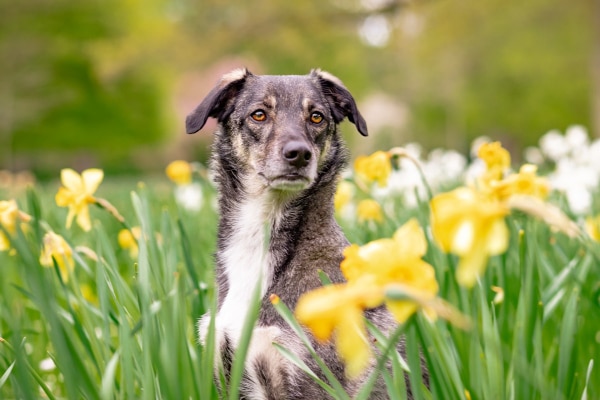
Some common plants that are popular choices for many gardeners can be potentially poisonous for our canine companions. But which ones? To help you plan ahead and keep your dog safe, I’ve put together this list of 10 common garden plants that are dangerous to dogs. (Plants are listed in alphabetical order.)
You’ll learn what each garden plant looks like, the signs and symptoms of poisoning in dogs for each outdoor plant, and what to do if your dog ingests a toxic plant. Help is here!
Let’s get started.
10 garden plants that are dangerous for dogs
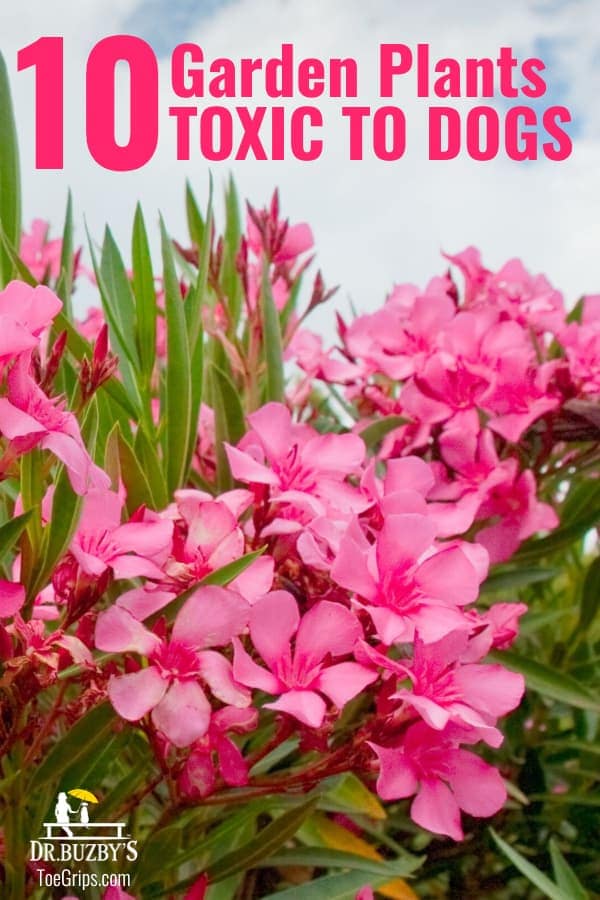
- 10 garden plants that are dangerous for dogs
- 1. Autumn Crocus: Highly poisonous to dogs
- 2. Azalea: Highly poisonous to dogs
- 3. Chrysanthemum: Less toxic, but still a plant that is poisonous to dogs
- 4. Daffodil: Mildly toxic in small amounts but can be problematic in larger amounts
- 5. English Ivy: Mild to moderately poisonous to dogs
- 6. Lily of the Valley: Moderate to severe toxicity for dogs
- 7. Oleander: An outdoor plant that is moderate to severely poisonous to dogs
- 8. Sago Palm: Highly poisonous to dogs
- 9. Tulip and Hyacinth: Mild to moderately poisonous to dogs
- 10. Yew: Highly poisonous to dogs
- Bonus plant: Tomatoes, which are mildly toxic when green or the dog eats the plant itself
- A caution for our feline friends: Lilies are highly poisonous to cats
- My dog ate a poisonous plant. What do I do?
- I'm concerned about what to plant in my garden. Which plants are safe for dogs?
- Top 10 Toxic Garden Plants Infographic (with photos)
- Keeping your dog safe outside and inside the home
- What questions do you have about garden plants that are dangerous to dogs?
1. Autumn Crocus: Highly poisonous to dogs

Autumn Crocus Toxicity Scale for Dogs: HIGH
There are many species of crocus, but the most dangerous species for dogs is the Autumn Crocus, Colchicum autumnale. The plant is originally from the Mediterranean and Asia.
The whole plant is poisonous to dogs when ingested, but the highest concentration of the toxin is found in the bulbs. Colchicine, the toxic agent in the plant, is highly toxic and can cause death when the dog eats as little as 0.8 milligrams per kilogram.
A dog’s symptoms caused by colchicine include:
- A burning sensation in the dog’s mouth and throat
- Vomiting and/or diarrhea that often has blood
- Seizures in dogs
- Liver failure in dogs and kidney failure in dogs
- Heart arrhythmias
- Sudden death
Toxin Trivia: Colchicine, the toxic agent in the Autumn Crocus, has been used for centuries to treat gout in humans.
2. Azalea: Highly poisonous to dogs

Azalea Toxicity Scale for Dogs: HIGH
Are azaleas poisonous to dogs? Yes.
There are over 250 species of Azalea (Rhododendron spp.) found throughout North America. Despite their beautiful showy flowers that can bloom any time from the spring through the fall, azaleas are popular outdoor plants that are highly toxic to dogs.
Symptoms can occur when a dog has consumed as little as 0.2% of his or her body weight. Grayanotoxins in azaleas primarily affect the dog’s heart and intestinal tract.
Symptoms of poisoning in dogs from azalea ingestion include:
- Vomiting
- Diarrhea with or without blood
- Drooling
- Changes in heart rate
- Arrhythmias
- Low blood pressure
- Seizures
- Coma
- And even death
Toxin Trivia: Bees that feed on a
3. Chrysanthemum: Less toxic, but still a plant that is poisonous to dogs

Chrysanthemum Toxicity Scale for Dogs: LOW
Are chrysanthemums poisonous to dogs? The good news is that chrysanthemums have a relatively low risk of fatal toxicity when consumed compared with other toxic plants on this list. However, while chrysanthemums are less toxic to dogs than some garden plants, they are still a plant that is poisonous to dogs.
Chrysanthemum (Chrysanthemum spp.) are beautiful flowering plants that are originally native to Asia. The toxic components of the plants include sesquiterpene, lactones, and pyrethrins.
Signs of toxicity in dogs from eating chrysanthemum can include:
- Drooling
- Vomiting
- Diarrhea
- Incoordination and imbalance may occur with extreme ingestion of the toxic components
Toxin Trivia: Pyrethrins are used as flea preventatives and derived from the flowers of the plant, while pyrethroids are the synthetic version of the compound naturally found in the plants. Dogs are more tolerant of pyrethrins than cats, and pyrethrin flea and tick preventatives can be used safely in dogs.
4. Daffodil: Mildly toxic in small amounts but can be problematic in larger amounts

Daffodil Toxicity Scale for Dogs: MILD TO MODERATE
Daffodils are probably one of the most recognizable signs that spring is on the way. All parts of the plant are toxic. But most of the toxic components, such as lycorine, other alkaloids, and calcium oxalates are found in the bulb of the plant.
Sometimes eating a small amount of the daffodil plant will only cause mild signs, but in larger amounts, daffodil ingestion (especially of the bulb) can cause some potentially dangerous symptoms.
Signs of toxicity in dogs from ingesting daffodil include:
- Oral irritation and drooling
Vomiting Diarrhea - Low blood pressure
- Low heart rate
- Cardiac arrhythmias
- Abnormal breathing
Toxin Trivia: Daffodils were first cultivated by the ancient Romans.
5. English Ivy: Mild to moderately poisonous to dogs
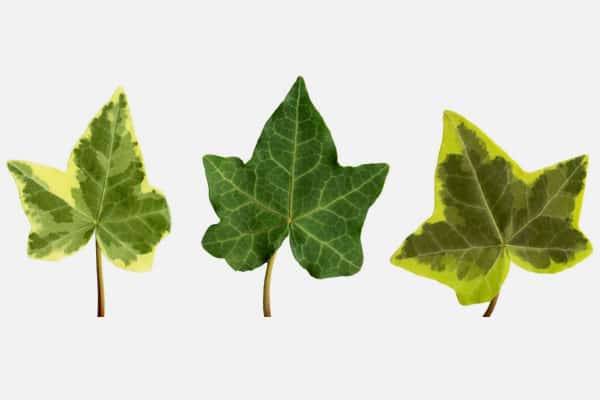
English Ivy Toxicity Scale: MILD TO MODERATE
English Ivy (Hedera helix) is sometimes kept as a houseplant. But it is probably most recognized for how it climbs up the sides of older buildings on colleges and historic homes. The toxic components of the plant, triterpenoid saponins, cause irritation of the mouth and intestinal tract when the dog consumes the leaves and berries.
Ivy has relatively mild to moderate effects compared with other toxic plants on this list, and the leaves contain more of the toxins than the berries.
Signs of toxicity in dogs from ingesting English Ivy may include:
- Oral irritation
- Drooling
- Vomiting
- Diarrhea
Toxin Trivia: Because English Ivy is an invasive species in the United States, sale of the plant is banned in Oregon.
6. Lily of the Valley: Moderate to severe toxicity for dogs
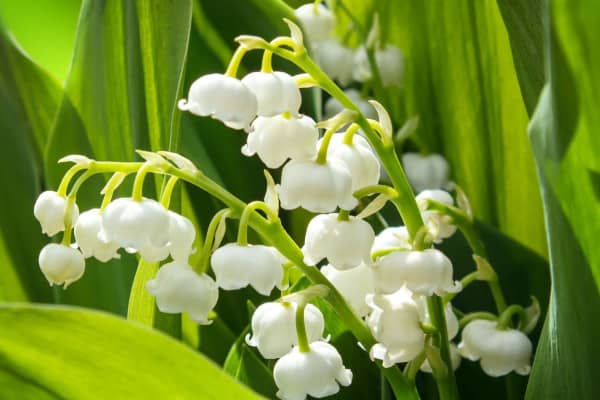
Lily of the Valley Toxicity Scale for Dogs: MODERATE TO SEVERE
The toxins in the lily of the valley plant are very potent and can be deadly for dogs if they eat any part of the plant.
Lily of the Valley (Convallaria majalis) is well known for its delicate, white flowers. Despite their seemingly innocent appearance, they contain deadly cardiac glycosides that work by affecting the electrical activity of the dog’s heart.
This can lead to signs of poisoning in dogs from lily of the valley such as:
- Vomiting
- Diarrhea
- A slowed heart rate
- Low blood pressure
- Seizures
- Death
Toxin Trivia: Lily of the valley is the national flower of Finland.
7. Oleander: An outdoor plant that is moderate to severely poisonous to dogs
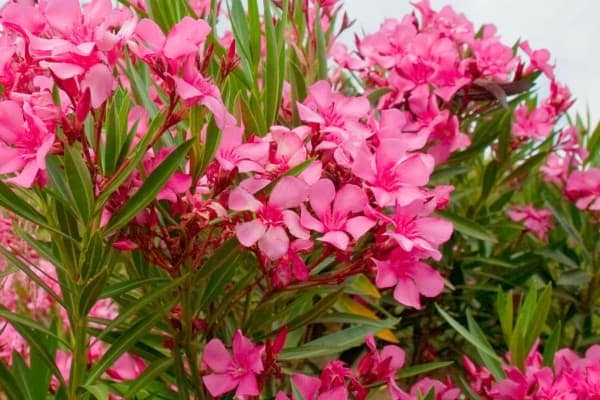
Oleander Toxicity Level for Dogs: MODERATE to SEVERE
Oleander (Nerium oleander) was originally native to Northwest Africa and Southeast
Signs of oleander plant toxicity in dogs include:
- Drooling
- Vomiting
- Diarrhea
- Arrhythmias
- Collapse
- Seizures
- Death
Toxin Trivia: The toxic dose of oleander in horses and cows is only 0.005% of their body weight.
8. Sago Palm: Highly poisonous to dogs
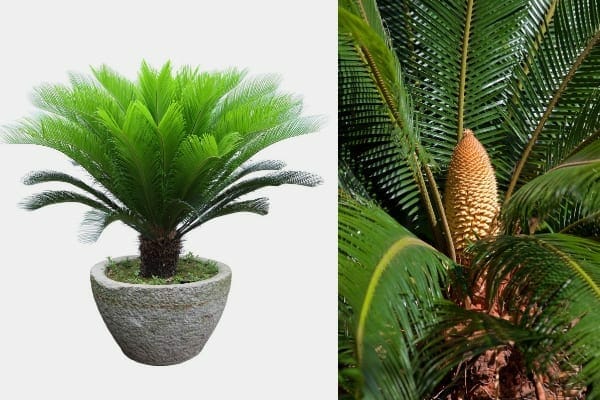
Sago Palm Toxicity Scale for Dogs: HIGH
Sago Palms (Cycas revoluta) contain a highly toxic agent known as cycasin. The molecule is found in the highest concentration in the seeds, but is found throughout the plant, too. Cycasin is broken down in the dog’s gut and causes significant damage to the liver.
Signs of toxicity such as vomiting, diarrhea, and drooling can be seen anywhere from 15 minutes to a couple of hours after ingestion of the sago palm by a dog.
Also, liver failure can occur two to three days after a dog ingests some of the sago palm. The liver failure may appear as vomiting, diarrhea, yellow appearance to the skin, fluid build up in the abdomen and neurological signs such as weakness and imbalance (i.e. a wobbly and off balance dog). Sago palms are a common garden plant and they are highly toxic to dogs.
Toxin Trivia: Although the sago palm superficially looks like a palm tree, it is not actually in the palm family. Palm trees are in the family Arecaceae, while sago palms are in the family Cycadaceae.
9. Tulip and Hyacinth: Mild to moderately poisonous to dogs
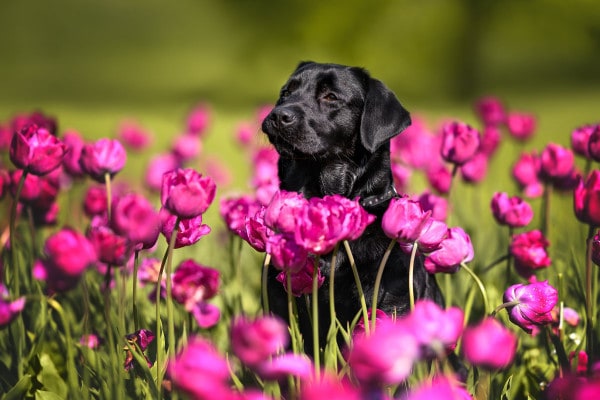
Tulip Toxicity Scale for Dogs: MILD TO MODERATE
Next, let’s look at two types of beautiful bulb flowers—the tulip and the hyacinth. Tulips (Tulipa spp.) and Hyacinth (Hyacinthus spp.) are two popular bulb species that both contain a similar toxin. Alkaloids are located in the highest concentration in the bulbs.

Hyacinth Toxicity Scale for Dogs: MILD TO MODERATE
Typical signs of toxicity in dogs from ingesting tulips or hyacinth include:
- Vomiting
- Diarrhea
- Drooling
- Oral irritation
- Increased heart rate and respiratory rate, trouble breathing (if large quantities are eaten)
Toxin Trivia: Hyacinth
10. Yew: Highly poisonous to dogs
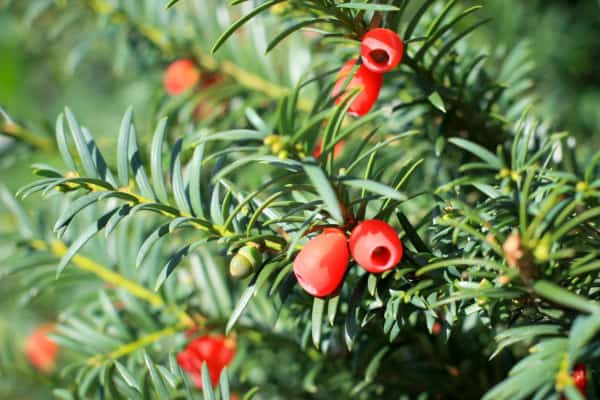
Yew Toxicity Scale for Dogs: HIGH
There are many species of yew, but the most toxic species to dogs are Japanese yew (Taxus cuspidate), English yew (Taxus baccata), and Chinese yew (Taxus
It only takes a small amount of exposure, such as a dog chewing on a yew branch, to cause signs of poisoning including:
- Drooling
- Vomiting
- Diarrhea
- Dilated pupils
- Trouble breathing
- Tremors
- Seizures
- Sudden changes in heart rate and blood pressure
- Sudden death
Thankfully, due to the bitter nature of yew, poisoning in dogs is rare.
Toxin Trivia: Taxol (paclitaxel), a chemotherapeutic medication used to treat cancer in humans, was originally derived from the Pacific yew tree.
Bonus plant: Tomatoes, which are mildly toxic when green or the dog eats the plant itself
While the plants on the list above are ornamental, you may also grow this popular plant in your vegetable garden…tomatoes.
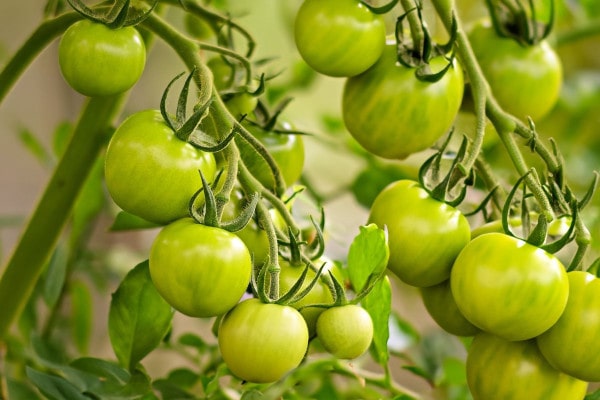
Tomato toxicity scale for dogs: MILD
If your dog is so inclined, there’s nothing wrong with letting him or her eat a ripe red tomato. But unripe green tomatoes and the plant itself are a different story.
Tomato plants, like many other members of the Solanaceae family, contain the toxic substance solanine. The highest amounts of solanine are in the green areas of the plant, which is why consuming the green tomatoes or the tomato stalks and leaves is problematic for dogs, but eating ripe red tomatoes is not.
Thankfully, eating green tomatoes or the stalks or leaves usually just leads to mild clinical signs such as:
- Drooling
- Lack of appetite
- GI upset (vomiting and diarrhea)
- Dilated pupils
- Depression
- Increased heart rate
While tomato toxicity is mild, if you are planning to grow tomatoes and think your dog might decide to help him or herself, you may want to put a fence around them just to be safe.
A caution for our feline friends: Lilies are highly poisonous to cats
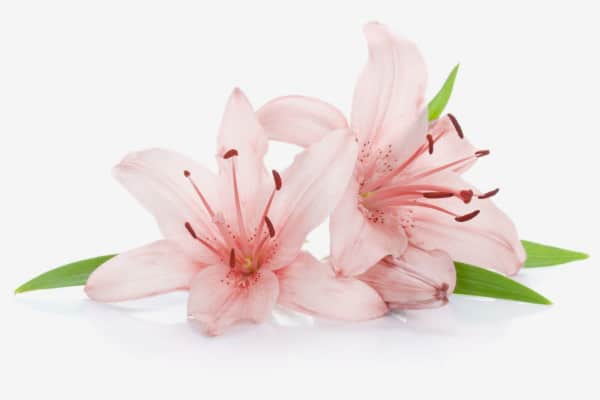
Lilly Toxicity Scale for CATS: HIGHLY toxic to cats
Even though dogs are the focus of this article, we cannot neglect our feline friends. Lilies are highly toxic to cats, to the point where even grooming pollen from the fur or drinking water out of a vase that holds lilies can cause kidney failure. Signs typically occur within 6 to 12 hours after exposure and include lethargy, decreased appetite, vomiting, diarrhea, changes in urination (either increased urination or no urine production), kidney failure, and some cats may show signs such as imbalance, head pressing, and seizures.
Next, let’s look at what steps to take if you think your dog may have ingested a toxic garden plant.
My dog ate a poisonous plant. What do I do?
If you think your dog ate a poisonous garden plant, don’t panic. Follow these three steps:
1. Call your veterinarian or animal poison control.
First, contact your veterinarian and/or animal poison control. The ASPCA Animal Poison Control Center and the Pet Poison Helpline have expert help available 24/7. (Note: There is a consult fee for these services.)
2. Take photos of the garden plant that you suspect is the culprit.
Grab your cell phone and take pictures of BOTH the plant and the label on the plant’s container—if the plant is still in its original container. This will greatly help with identification.
3. Act quickly.
For most toxicity cases, it is better to seek help and start treatment early instead of waiting to see what happens. Also, you can be prepared by knowing what to expect if you need an emergency vet visit for your dog.
I’m concerned about what to plant in my garden. Which plants are safe for dogs?
If you are debating which plants are safe for your garden, the ASPCA Poison Control has a helpful website for identifying a wide variety of toxic and nontoxic plants. For an entire list of garden plants dangerous to dogs as well as a list of plants that are safe for dogs, see the ASPCA’s article: Toxic and Nontoxic Plants.
Top 10 Toxic Garden Plants Infographic (with photos)
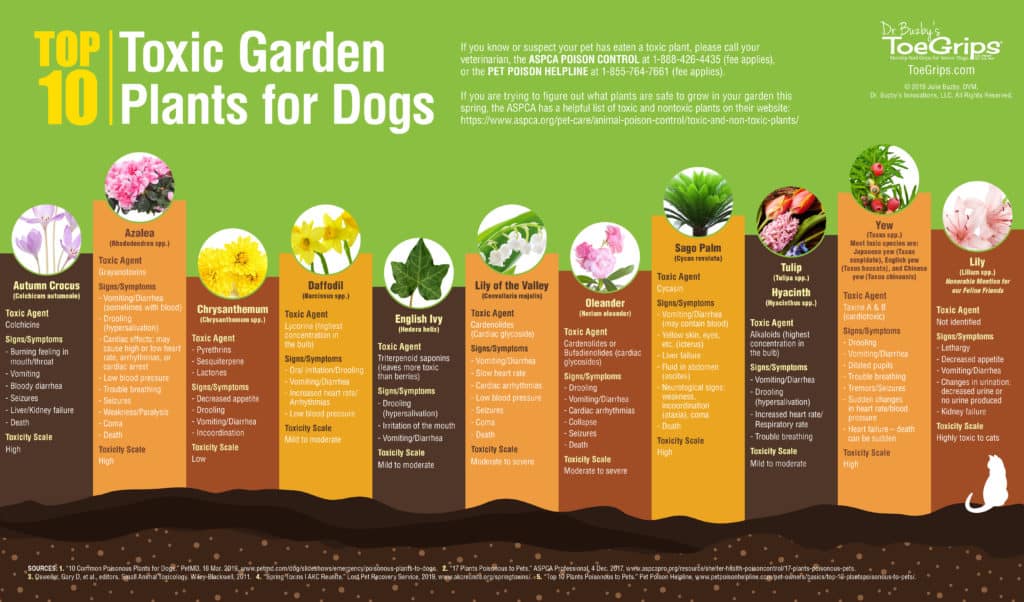
Keeping your dog safe outside and inside the home
As your dog’s biggest advocate, you work hard to give your dog the best life possible. You protect your canine companion inside your home by keeping xylitol, chocolate, grapes and raisins, and even human toothpaste out of reach. Now you can protect your dog from common garden plants that may be outside your own home.
Finally, as summer heats up, please keep your dog safe from another outdoor danger—
By educating and informing yourself about outdoor plants that are dangerous for dogs, you can enjoy your garden and the outdoors…and your dog can, too.
What questions do you have about garden plants that are dangerous to dogs?
I’d love to hear. Please comment below.
Sources:
- “10 Common Poisonous Plants for Dogs.” PetMD, 18 Mar. 2019, www.petmd.com/dog/slideshows/emergency/poisonous-plants-to-dogs.
- “17 Plants Poisonous to Pets.” ASPCA Professional, 4 Dec. 2017, www.aspcapro.org/resource/shelter-health-poison-control/17-plants-poisonous-pets.
- Knight, Tony. “Guide to Poisonous Plants.” Guide to Poisonous Plants – College of Veterinary Medicine and Biomedical Sciences – Colorado State University, 2019, https://csuvth.colostate.edu/poisonous_plants/.
- Osweiler, Gary D, et al., editors. Small Animal Toxicology. Wiley-Blackwell, 2011.
- “Science and Nature Team Up Against Breast and Ovarian Cancers.” National Cancer Institute, 31 Mar. 2015, www.cancer.gov/research/progress/discovery/taxol.
- “Spring Toxins | AKC Reunite.” Lost Pet Recovery Service, 2019, www.akcreunite.org/springtoxins/.
- “Top 10 Plants Poisonous to Pets.” Pet Poison Helpline, www.petpoisonhelpline.com/pet-owners/basics/top-10-plants-poisonous-to-pets/.


I’m wondering HOW the plants are toxic for dogs?
Do they touch them, smell them, eat them?
Just trying to figure out how the dogs get the toxins?
Hi Robin,
Good question. Typically it’s ingestion that we’re concerned about. Here’s another example: https://toegrips.com/blue-green-algae-and-dogs-a-deadly-combination/
my dog jumped into my planter box that had muma and other plants to retreive her ball within an hour her face swelled up and her throat was closing we called our vet he told us to give her benadryl we gave her two mixed in butter and another half an hour later the swelliung went down we also washed her face with warm water on a clean cloth several times it took awhile buy the swelling went down and she improved i have since stopped using plants that are toxic to my girls
Hi Anni,
Wow, I can only imagine how scary that must have been! I am glad the Benadryl worked and nothing more serious developed. Thank you for sharing your experience with us. Great job!
Thanks for this.
You are so welcome, Kim! Thanks for reading!
This is so helpful! Thank you so much.
Hi Veronique,
Thank you for the positive feedback!